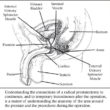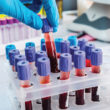Hormonal Therapy Treatment for Prostate Cancer
The following article contains a good deal of technical information, but we feel the information is helpful and would be of interest to many of our QUEST readers.
Hormonal therapy is most often used after both a radical prostatectomy and radiation have failed. Sometimes, however, it is used as a primary therapy in older patients who would not tolerate surgery or radiation.
Hormonal therapy can be divided into two phases, primary and secondary.
Primary
Most prostate cancer cells either die or go into a dormant phase when the male, blood hormonal level (testosterone) level is dramatically lowered. This phase of so-called “androgen-dependent” prostate cancer can be quite variable, lasting from only a few months to as long as 18 years. Male hormone levels can be lowered or rendered less effective in various ways.
One method of lowering the testosterone level is by removal of the testicles (called castration or orchiectomy). Another is by injections called Lupron (leuprolide) or Zoladex (goserelin). A third alternative is antiandrogen pills such as Megace (megestrol), Eulexin (flutamide), Casodex (bicalutamide), Nilandron (nilutamide).
Other methods are by estrogens (diethylstilbestrol, estrace); by inhibitors of androgen synthesis, such as ketoconazole; by antiestrogens, such as tamoxifen; by herbal estrogen compounds, such as PC spes; or by glucocorticoids (such as prednisone or dexamethasone).
Secondary
In a second phase, the tumor can grow even though the male hormone level is low. During this phase, the tumor cells still can be controlled by discontinuing some drugs that were being taken previously or by switching to a different drug. This administration and withdrawal of hormones is called secondary hormonal therapy.
The principle behind secondary hormonal therapy is that while the patient is taking a hormone (such as Eulexin) that blocks the growth of the cancer, the cancer cells can mutate or change in a way that makes the Eulexin stimulate their growth.
In this situation, simply stopping the Eulexin can have a beneficial effect and may lower the PSA for a period of 3 to 9 months in 20% to 50% of cases. After a while, the PSA will again begin to rise. When this occurs, other similar drugs of the antiandrogen family, such as Casodex, Nilandron, Megace, may be started and the PSA will again decrease for a period of time.
If the cancer cells again mutate and become stimulated to grow by the new drug, the new drug may be stopped and again, in some cases, the PSA will again decrease.
In this way, it is sometimes possible to use a variety of drugs, switching from one to another, to achieve an additional response. (Megestrol acetate should be avoided in patients with heart disease, high blood pressure, or diabetes.)
When antiandrogen drugs no longer work, it is possible in some cases, to achieve additional responses with other hormonal agents, such as Nizoral ketoconazole), Cytadren (aminoglutethimide), Stilphostrol (diethylstilbesterol diphosphate), or PC Spes (Chinese herbal estrogen preparation). (Some of these drugs, such as Nizoral and Cytadren require the additional use of cortisone-like medications, because they suppress the production of cortisol by the adrenal glands.)
Hormone-Resistant
Even after prostate cancer cells reach the stage at which they are no longer responsive to hormone therapy, they still may be sensitive to treatment with radiation, chemotherapy or experimental drugs. Patients may not develop symptoms of metastatic prostate cancer (such as pain or weight loss) until the PSA has reached a level of 100 to 300. Some patients with very advanced disease have PSA levels in the thousands.
Each tumor is somewhat unique in its behavior as is each patient. Measurement of PSA levels is the best way of determining the response of therapy. In general, if the PSA level can be decreased by 50%, survival is usually prolonged.
Chemotherapy
Significant responses can be achieved with chemotherapy, although, in general, chemotherapy is less effective and has more side effects than primary hormonal therapy. However, some regimens are very well tolerated and offer reasonable prospects for benefit.
One such regimen is mitoxantrone plus prednisone. This regimen may improve the quality of life, but does not appear to prolong survival. Another combination that is also sometimes effective is estramustine in combination with vinblastine. Other combinations include etoposide, doxorubicin, and cyclophosphamide.
Recently taxol drugs (docetaxel) have been combined with estramustine and hydrocortisone for men with hormone refractory prostate cancer. One regimen combines these drugs with thalidomide, which works as an agent that blocks the growth of blood vessels that feed the tumor.
Spot radiation therapy can be effective in reducing pain from bone metastases and protects against the development of pathologic fractures, fractures that occur because the bone dissolves away because of the homone or is eaten away by the cancer.
Biphosphonates (pamidronate and etidronate) inhibit bone deterioration and may also be used to prevent fractures and to treat bone pain.
The goals in treating advanced prostate cancer are to maintain a high quality of life, relieve symptoms, and prolong survival. These goals can require the use of other medications such as nonsteroidal anti-inflammatory agents as well as stronger narcotic medications.
Several new drugs and approaches are under investigation. Further research will certainly bring new and more effective treatments for hormone-refractory prostate cancer, advanced prostate cancer which no longer responds to treatment with hormones.











